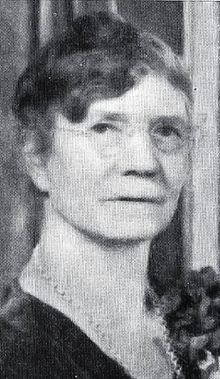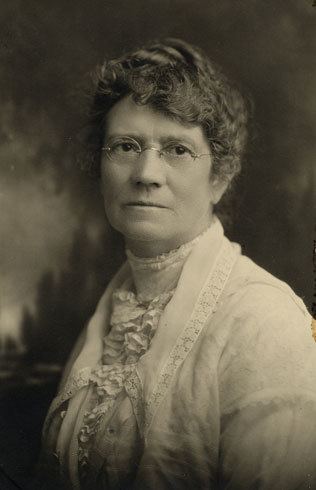Children 12 Name Ruth Fox | Full Name Ruth May Spouse(s) Jesse William Fox Predecessor Martha H. Tingey | |
 | ||
Born November 16, 1853Westbury, England ( 1853-11-16 ) Resting place Salt Lake City Cemetery40°46′37″N 111°51′29″W / 40.777°N 111.858°W / 40.777; -111.858 (Salt Lake City Cemetery) Parents James MayMary A. Harding Similar People John Taylor, Heber J Grant, George Q Cannon, George Albert Smith, Wilford Woodruff | ||
Ruth May Fox (November 16, 1853 – April 12, 1958) was a nineteenth-century English-born women's rights activist in the Territory of Utah. Fox was a poet, hymn writer, and a leader of youth in The Church of Jesus Christ of Latter-day Saints (LDS Church).
Contents
- Early life
- Family
- Womens suffrage and civil service
- Church leadership
- Later life and death
- Articles
- Poetry
- References

Early life
Ruth May was born in Westbury, Wiltshire, England to James May and Mary Ann Harding. When May was five months old, her parents converted to Mormonism. Her mother died in childbirth when Ruth was 18 months old. May was sent to live with various relatives and Mormon families while her father was a traveling missionary. Lacking parental consistency, Ruth misbehaved often as a child. At one point she accidentally set her hair on fire, and another time she stepped in front of an oncoming train. At age 8, Ruth returned to live with her father in Yorkshire in a boarding house run by Mary Saxton. As an older child, Ruth enjoyed reciting poetry and telling stories and working alongside Mary Saxton's daughter Clara.
In 1865, James May emigrated to the United States and shortly thereafter sent for Ruth, Mrs. Saxton, and Clara. On their arrival in Philadelphia, James May married Mrs. Saxton, and he and the two girls found work in a textile mill to save money to go to Utah Territory. In 1867 the family traveled by covered wagon and on foot to Salt Lake City with Leonard Rice's company. After settling in the Ogden area, Ruth attended John Morgan's College in Salt Lake City for four months. When James bought a mill in Salt Lake City, Ruth worked for him operating equipment usually run by men. She felt that she should be paid a man's wages for the job since she was paid a lower wage as a woman.
Family
On May 8, 1873, Ruth married Jesse W. Fox, Jr., a civil engineer. In 1888, Jesse Fox married Rosemary Johnson as a plural wife without Ruth's permission, although for most of his life, Jesse resided with Ruth. Ruth eventually became the mother of twelve children. Jesse lost his dry goods business and their home, but not their farm. Ruth was on her own to provide for her own children. In 1900 Ruth managed the Saint Omer Boarding house. In 1914 she worked as a typist for the LDS church's Young Ladies' Mutual Improvement Association (YLMIA). During her time as a typist, her father's health was declining, and Ruth rented a home for her and her father near the YLMIA offices. In 1953, she had over 200 direct descendants.
Women's suffrage and civil service
Fox continued her education through observation and personal study. She composed poetry, which first appeared in print in 1891, at which time she joined the Press Club, a women's literary organization. She was a member of Emmeline B. Wells's Reapers Club, which encouraged the social and intellectual development of women. Fox considered herself a disciple of Wells, who inspired Fox to become more active in the women's suffrage movement.
Fox actively promoted the women's suffrage movement in Utah and did so largely as an organizer of Republican Party in Utah. She was president of the Utah Woman's Press Club, chair of the Second Precinct Ladies' Republican Club, treasurer of the Utah Woman Suffrage Association, and was a member of the Salt Lake County Republican Committee and the Traveler's Aid Society. In the late 19th century she worked for the inclusion of woman suffrage in the Utah state constitution and helped draft the suffrage memorial presented and accepted by the 1895 Utah constitutional convention. Fox and Emmeline B. Wells met with Susan B. Anthony and Anna Howard Shaw when they visited Salt Lake City on May 12, 1895.
Heber Manning Wells, the first governor of Utah, appointed Fox as a director of the Deseret Agricultural and Manufacturing Society, a position which she held for eight years. During this time, she helped invigorate the Utah State fair. Fox also was active in serving for the American Red Cross in Utah. She served on the executive board. During the influenza epidemic of 1917 she served as a volunteer nurse to the sick. During World War I, she served as lieutenant of canteens in Salt Lake city
Church leadership
In 1905, Fox was asked to be the first counselor to Martha Horne Tingey in the general presidency of the YLMIA. In 1923 the YLMIA general board published a volume of Fox's poetry under the title May Blossoms. Fox served as first counselor in the YLMIA until 1925, when she was 75 and she became the third general president of the YLMIA under church president Heber J. Grant.
During Fox's tenure as president, a number of changes to the young women's program occurred. In 1934, the name of the young women's program changed to the Young Women's Mutual Improvement Association (YWMIA) to parallel the name of the Young Men's organization, the Young Men's Mutual Improvement Association. Twelve and thirteen-year-old girls became beehives in the YWMIA instead of Mi-Kan-Wees in Primary. They could purchase a uniform similar to the Boy Scout uniform. She changed the Lion House into a "home for girls" for them to socialize and attend classes in religion and writing; some 50 out-of-town young women lived there. Fox sponsored a Traveling Library Program. As part of her duties as leader of the YLMIA, Fox visited and taught women all over the world in their local wards. She visited Hawaii and Europe.
In 1930, Fox wrote the hymn "Carry On" for the centennial celebration of the church. In 1995, "Carry On" was adopted by Gordon B. Hinckley as the theme of his tenure as President of the Church.
Fox served until 1937, when she was succeeded by her own first counselor, Lucy Grant Cannon.
Later life and death
Fox's 85th, 90th, 95th, and 100th birthday parties were held in the Beehive House and were attended by members of the First Presidency, the Council of the Twelve Apostles, other Church leaders, and city and state officials. She was 103 when she flew on an airplane to celebrate the golden wedding anniversary of one her sons. Fox died in Salt Lake City at the age of 104. Fox said: "Life brings some hard lessons. The sturdiest plants are not grown under glass, and strength of character is not derived from the avoidance of problems."
